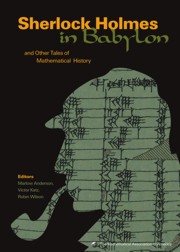Book contents
- Frontmatter
- Introduction
- Contents
- Ancient Mathematics
- Medieval and Renaissance Mathematics
- The Seventeenth Century
- The Eighteenth Century
- Foreword
- Brook Taylor and the Mathematical Theory of Linear Perspective
- Was Newton's Calculus a Dead End? The Continental Influence of Maclaurin's Treatise of Fluxions
- Discussion of Fluxions: from Berkeley to Woodhouse
- The Bernoullis and the Harmonic Series
- Leonhard Euler 1707–1783
- The Number e
- Euler's Vision of a General Partial Differential Calculus for a Generalized Kind of Function
- Euler and the Fundamental Theorem of Algebra
- Euler and Differentials
- Euler and Quadratic Reciprocity
- Afterword
- Index
- About the Editors
Discussion of Fluxions: from Berkeley to Woodhouse
from The Eighteenth Century
- Frontmatter
- Introduction
- Contents
- Ancient Mathematics
- Medieval and Renaissance Mathematics
- The Seventeenth Century
- The Eighteenth Century
- Foreword
- Brook Taylor and the Mathematical Theory of Linear Perspective
- Was Newton's Calculus a Dead End? The Continental Influence of Maclaurin's Treatise of Fluxions
- Discussion of Fluxions: from Berkeley to Woodhouse
- The Bernoullis and the Harmonic Series
- Leonhard Euler 1707–1783
- The Number e
- Euler's Vision of a General Partial Differential Calculus for a Generalized Kind of Function
- Euler and the Fundamental Theorem of Algebra
- Euler and Differentials
- Euler and Quadratic Reciprocity
- Afterword
- Index
- About the Editors
Summary
The first direct statement of Newton's method and notation of fluxions was printed in 1693 in Wallis's Algebra. Here and in the Principia of 1687 Newton made use of infinitely small quantities, but in his Quadrature of Curves of 1704 he declared that “in the method of fluxions there is no necessity of introducing figures infinitely small.” No other publication of Newton, printed either before 1704 or after, equalled the “Quadrature of Curves” in mathematical rigor. Here Newton reached his high water mark of rigidity in the exposition of fluxions. By a fluxion, Newton always meant a finite velocity. With one exception, all British writers on the new calculus before the appearance of Berkeley's Analyst in 1734 used the Newtonian notation consisting of dots or “prick'd letters,” and also Newton's word “fluxion.” But strange to say, most of these writers did not use Newton's concepts. They applied the term “fluxion” to the infinitely small quantities of Leibniz—thus using a home label on goods of foreign manufacture. Of sixteen or more writers in Great Britain during the period of 1693–1734, nine or more call a fluxion an infinitely small quantity; three writers do not define their terms, while only four follow Newton's exposition of 1687 or 1693, involving fluxions as finite velocities and “moments” as infinitely small quantities, or else follow Newton's exposition of 1704, involving fluxions as finite velocities and avoiding infinitely small quantities almost entirely.
- Type
- Chapter
- Information
- Sherlock Holmes in BabylonAnd Other Tales of Mathematical History, pp. 325 - 331Publisher: Mathematical Association of AmericaPrint publication year: 2003



